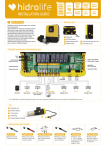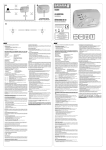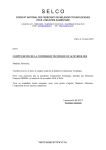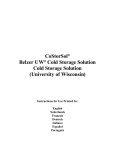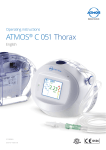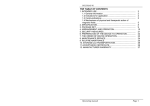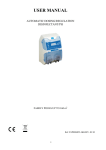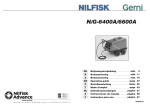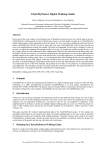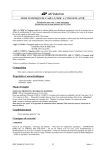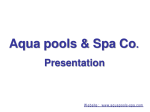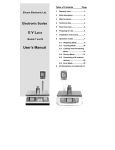Download USER`S MANUAL
Transcript
USER’S MANUAL Products for Water Maintenance POOLS, MAINTENED WITH FRIENDLY WATER PRODUCTS RANGE Azalia Hotel and Spa, Sts. Constantine and Helena Resort Kempinski Hotel Grand Arena, Bansko Contents FRIENDLY WATER - ALWAYS CRYSTAL CLEAR WATER 2 MAIN STAGES OF THE MAINTENANCE OF WATER 4 I. Shock Chlorination (Super chlorination) 1. Putting the Filtration system into a good working form: 2. Swimming pool water testing (with tester) 3. PH value regulation: 4. Chlorination: 5. Shock treatment with algaecide: 6. Shock treatment with flocculant: 4 4 4 4 5 5 5 II. Permanent water treatment 1. PH value regulation 2. Adjusting the total alkalinity, calcium hardness and cyanuric acid 3. Water disinfection with chlorine, bromine and active oxygen 4. Prevention of algae formation 5. Water flocculation 6 7 9 11 16 17 III. Swimming pool winterizing Swimming pool care when you are away from home Other disinfecting detergents - disadvantages and usage. 18 19 19 PRODUCTS RANGE рН Minus granulat РН Minus Liquid pН Plus Granulat РН Plus Liquid Flashchlor-granules 65 Flashchlor granules 90 Flashchlor tablets 200 g Multifunctional tablets 200 g Flashchlor liquid Flashchlor Regulator Aquazone О2 Aquazone А Aquazone liquid Algi Flox – concentrated granulat Flox liquid Whirlpool Set II Whirlpool Set IV 21 22 23 24 25 26 27 28 29 30 31 32 33 34 35 36 37 38 39 Aquazone Br2 /20 g tablets/ Anti foam - Entschaumer Winterfix Dekaltsit Antikalk 40 41 42 43 44 Introduction FRIENDLY WATER - ALWAYS CRYSTAL CLEAR WATER The swimming pool is an attractive living environment for many microorganisms, fungi, bakterii and viruses. Some of them are virulent, but even harmless, they can produce slippery slobber and waste due to their rapid reproduction. A well functioning filtration system is only part of the purification of water in the pool. Another important and equally important part is its chemical treatment. Filtered system usually takes the mechanical functions of water treatment, while the chemical treatment is necessary stage of oxidation and destruction of microorganisms and viruses. Intended purpose chemicals usually added by hand to the private pools, while the public is imperative in their dosage or semi-automatic dosing systems. For precise calculation of effective and economical water treatment for your swimming pool it is important the pool volume to be properly calculated. For fast and accurate calculation we have included some universal formulas. Please choose a swimming pool shape that best corresponds to the shape of your own swimming pool, put the exact dimensions and multiply by the coefficient in the formula. As a result you will receive the water volume which is supposed to be chemically treated. Introduction Fig.1 Universal formula for calculating the volume of water in the pool Length Width Average depth RECTANGULAR POOL Length Width Average depth OVAL POOL Diameter Diameter Average depth ROUND POOL Maximum length Maximum width Average depth POOL WITH OTHER FORMS Swimming pool water treatment. Main stages MAIN STAGES OF THE MAINTENANCE OF WATER Swimming pool water treatment contains 3 main stages: I. Shock chlorination – to be applied at the beginning of the season, before primary filling or if the quality characteristics of swimming pool water are sharply lowered. II. Permanent water treatment. III. Outside swimming pools winterizing for the winter period. I. Shock Chlorination (Super chlorination) Shock chlorination means sharply to increase the chlorine levels in order resistant bacteria to be eliminated and chloramines to be unfenced. Shock chlorination is usually recommended when the water temperature is high, after heavy and long rain periods or/and in case of highly used swimming pool. Do not use the swimming pool immediately after shock chlorination! 1. Putting the Filtration system into a good working form: a) Skimmer baskets cleaning (if any); b) Inspection of the pre-filter baskets of the pumps – for cleaning if necessary; c) Inspection of the filtration agent quantity; d) Fresh water filling up to the necessary level; 2. Swimming pool water testing (with tester) It is made in order to define the indicators’ exceptions according to the given norm. 3. PH value regulation: The pH value of the water indicates whether and to what extent the water is alkaline or acidic. The pH value regulation is very important as it influences on the chlorine ability to kill bacteria and to dissolve the sediments of insoluble substances in the water. The quantity acid (alkali) needed for pH level maintaining and the total alkalinity is determined as acidity (alkalinity). The quantity pH regulator (reducing or rising the pH level) should be calculated so as the pH level to be between 7.2 and 7.6. I. Shock treatment 4. Chlorination: Chlorination is adding the proper quantity chlorine in the swimming pool water that causes sediments and impurities dissolving, cellular structure of bacteria and spores destroying and vegetative cells of viruses, fungi and actinomyces destroying. The surplus (free) chlorine is the quantity chlorine that remains in uncombined state after the necessary chlorination has been made. This surplus chlorine maintains the water clean. It is very important the surplus chlorine level to be controlled as it interacts with organic impurities and forms compounds named chloramines. Chloramines are with unpleasant smell, cause eye and respiratory apparatus irritation. With chloramines formation, chlorine looses its effectiveness and becomes unfit for use as a disinfectant. Chlorination stages: a) Shock chlorination with Flashchlor liquid b) Chlorine level stabilizing with Flashchlor 90 (quality between 0,8-1) 5. Shock treatment with algaecide: Water treatment with algaecide prevents from algae formation. Treatment with algaecide should be made no earlier than 24 hours after the shocks affecting treatment. It prevents and stops the spread of algae. At the beginning of the season when starting the installation (or after major cleaning of the pool) spray the walls, all edges and joints with 1% alginate in water. Then fill the pool and treat it as cost rate specified on the product label. 6. Shock treatment with flocculant: Treatment with flocculant should be made no earlier than 24 hours after the shocks affecting algaecide treatment. Flocculant agglomerates the finest fractions of organic and inorganic compounds. Their size increases and they can be easily extracted out of the water phase mechanically by means of effective filtration or by vacuum cleaner. II. Permanent water treatment II. Permanent water treatment The Permanent water treatment includes the following 4 stages: 1. pH value regulation 2. Water disinfection with chlorine, bromine or active oxygen 3. Prevention of algae formation 4. Coagulation /Flocculation 1 pH VALUE REGULATION 2 DISINFECTION with chlorine, bromine and active oxygen 3 PREVENTION OF ALGAE FORMATION 4 COAGULATION /FLOCCULATION II. Permanent water treatment 1. PH value regulation PH level is a measure of the hydrogen ion concentration in gram equivalents per litre of a solution and, therefore, its acidity or alkalinity. The main values of pH are: Hydrogen ions concentration = 0 – acidity, i.e.water has the characteristics of acid; Hydrogen ions concentration = 7.0 - neutrality (distilled water has pH of 7); Hydrogen ions concentration =14.0 – alkalinity, i.e. has the characteristics of alkali; PH level should be maintained between 7.2 and 7.6. This value is determined by several important factors: – biology and human health – the structure of tissues and organs that form the human body determine the neutral to slightly alkaline reaction of water phase – water; – durability of the materials used for swimming pool construction (glass mosaic, filtration system, piping etc.); – optimal effect of swimming pool water treatment chemicals; The pH level depends on the water qualities and its chemical and micro biological composition. That is why swimming pool water must be periodically tested using manual tester – every day for public swimming pools and minimum every 4 days for the private pools. 7.0 7.1 7.2 - Corrosion - Loss of chlorine - Irritating water 7.3 7.4 - An ideal area for pH - Maximize the efficiency of chlorine - Comfort zone to bathers 7.5 7.6 7.7 7.8 - Lack of effectiveness of chlorine - Postponement of the limestone - Irritating water II. Permanent water treatment If water is too “hard”, i.e. if it contains a big quantity dissolved calcium, magnesium and other metal ions (cations), there is a tendency of quick pH level rising with visible variation in the water quality. In this case pH level should be corrected by adding to the water a product on acid base named “рН-Minus” (granules or liquid). “Soft” water is easier for chemical treating. If pH value is low, a product on alkali base (рН-Plus) should be added to the water. In case of pH level deviation from the values 7.2 – 7.6, the following problems might be faced: If a high level of pH is measured there is a risk of: – Destruction of the natural acid protective membrane of tissues that form visual, respiratory organs as well as tissue tone. As a result different irritations appear; – Limestone precipitation if water is hard or moderately hard. This causes sand calcification in the filters as well as water colouring in turbid white; – Reducing the effect of disinfecting products which increases their consumption; – Amino acids and albumens may be composed as a result of vital activity of micro organisms that form the natural water micro flora and may produce slimy deposits; – Unpleasant smells may occur as a result of chloramines formation; If a low level of pH is measured there is a risk of: – the metal components and materials in the swimming pool may corrode; – connections containing cement may be attacked; II. Permanent water treatment 2. Adjusting the total alkalinity, calcium hardness and cyanuric acid 2.1. Adjust total alkalinity Alkalinity is a measure of the total concentration of alkalis, most are bicarbonate dissolved in water. The higher it is, the more water become resistant (stable) of a changes in pH. High alkalinity contributes to formation of problems, connected with deposition of limestone in the filter equipment, pumps and pipes. With high alkalinity it is necessary to add a regulator “pH Minus” (granular or liquid). In the case of low alkalinity it is necessary an addition of “pH-Plus. 40 60 80 100 120 140 160 180 Low alkalinity - Corrosion - Lower pH - Eye irritation EXCELLENT ZONE 20 200 220 240 High alkalinity - Difficult to regulate pH - High pH - Cloudy water Each week it is necessary to control the levels of alkalinity and bring them into the range of 80-120 ppm (mg./l.) 2.2. Regulation of calcium hardness Calcium hardness is the amount of calcium dissolved in water plus some other minerals such as magnesium. Too much calcium means muddy water and limestone deposits, and too little can lead to corrosion of the cement parts of the pool. To correct the levels of the calcium hardness it is necessary to contact your service and pool chemicals delivery partner. II. Permanent water treatment Low calcium hardness - Ulcers in plastic and cement surfaces 400 EXCELLENT ZONE 200 High calcium hardness - Separation of limestone - Eye irritation - Cloudy water Each month it is necessary to monitor levels of calcium hardness and bring them into the range of 200-400 ppm (mg./l.) 2.3. Adjusting isocyanuric acid The chlorine can be easily exhale from the sunlight. In one sunny day up to 2 ppm (mg./l.) chlorine can be lost for a few hours. A few years ago isocyanuric acid was invented which binds with chlorine and so it is becoming significantly more resistant at the sunlight. The aim of the isocyanuric acid is only to stabilized and to make the chlorine more resistant at the sunlight. A problem could arise when the acid in the pool becomes too much- the chlorine becomes pre-stabilised The only solution in that case is a shock treatment with chlorine and reversed rinsing. The limit of the acid is 150 ppm (mg./l.) the maximum is 50 – 60 and the optimal quantity is 30 ppm. The negative site of that acid is the destroying the cuprum parts. Well treated pool water is when every single parameter of the chemicals levels (ph, alkale scence calcium harness, and cyanuric acid) are monitored and maintained in the right levels. The right alcalescence is helping the ph to be in the right level so the chlorine can finish the right maintenance of the water. The stabilizer is holding more chlorine in the water. The result is Crystal clear clean swimming pool. 10 II. Permanent water treatment 3. Water disinfection with chlorine, bromine and active oxygen Disinfection: Swimming pool water provides conducive living conditions for various micro organisms (bacteria, algae, fungi). They are classified as pathogenic (those which cause different diseases) and nonpathogenic – saprophytic (harmless). Saprophytic micro organisms are very fast reproducing, cause slimy deposits on the swimming pool walls and bottom. Pathogenic micro organisms besides this may cause diseases (swimming in public pools which are not chemically treated may cause dissemination of venereal diseases, allergies, and skin eruptions). That is why it is a must swimming pools to be effectively treated with chemicals in order microbial flora in the water to be eliminated. There are a few methods of water disinfection: 1. Ccommon – water treatment with chlorine products; 2. Disinfection with bromine – this method is used for water treatment in spas and pools with average water temperature over 30°C; 3. Disinfection with active oxygen – one of the newest modern methods which at the same time is one of the most effective methods; 4. Water disinfection with ozone – in this method ozone systems are used. 3.1. Chlorine disinfection: Chlorine is halogen non-metal element with a high oxidative ability. This ability of chlorine kills micro organisms by means of process close to combustion. The chlorine destroys the organic and inorganic impurities which cannot be filtered but get mixed with the water and create conditions for nutritive ambient formation for bacteria and fungi. The modern products we offer you are much more effective than chlorine and also have combined functions complying with the European standards for swimming pool water treatment of private and public pools. The requirements for swimming pool water quality are: - High content of active chlorine – its concentration in the water should have stable values for a long time; - Dissolving in the water without any chemical sediments; - Stable pH level - Stabilization of the free chlorine in the water even at conditions of intensive sunshine and high temperatures of the swimming pool water. 11 II. Permanent water treatment 3.2. Bromine disinfection: From chemical point of view Bromine is a halogen non-metal element of 7A group like chlorine. In Mendeleev periodic table bromine comes after chlorine, therefore it is more stable and higher oxidative ability – that is the reason it is used. Bromine is extracted from sea water and is remarkably effective in organic and inorganic combinations elimination and harmful micro flora destroying. Bromine is used for disinfection of swimming pools with high temperature of water (above 30°C) and for whirlpools with filtration system disinfection. Bromine has the following advantages: – No odour; – It is stable and regenerates up to 15% after pouring into the swimming pool water. This determines its lower consumption compared to chlorine; – It does not harm eyes, skin and hair; – It is still active in conditions of intensive sunshine, high pH levels and high water temperature 3.3. Active oxygen disinfection: Oxygen is a strong oxidizer /10 times stronger than chlorine/ and has a strong bactericidal effect against bacteria, viruses and harmful micro organisms. With active oxygen disinfection an important disadvantage is avoided, which is often met when chlorine products are used – chloramines formation (chemical combinations with bad odor which cause skin irritation). Active oxygen disinfection has the following important advantages: – No odour; – Oxygen is more stable at high water temperatures; – Water becomes soft and pleasant for bathing; – Differing from chlorine, active oxygen disinfects water; – Oxygen dissolves without any residua; – It does not harm eyes and skin; – Does not dry hair and skin; – Does not bleach swimming suits. 12 II. Permanent water treatment 3.4. Ozone treatment: Ozone is an allotrope of oxygen and consisting of three oxygen molecules. In neutral water it is very stable. It is soluble in water and in some organic solvents. Ozone is the strongest oxidizer. Ozonating is an effective process for destruction of surface-active substances. Technically ozone has a variety of priorities over chlorine because it ensures fuller and more intensive purifying processes without any harmful chemical compounds formation. With proper water treatment with ozone the results are not only absolute disinfection but also: - Water becomes crystal clear, with no odour; - Bad taste of water disappears; - Ozone removes iron and manganese from the water; - Ozone oxidizes sulphides, nitrite and hydrogen sulphide; - Ozone removes phenol and its compounds; - Ozone dissolves detergents and pesticides. Ozone dosing varies depending on the organic substances content in the water, water temperature and the pH level. Bactericidal dose of ozone for 99% of harmful bacteria removal for 5 minutes is 0,3 - 0,4 mg/l. Besides the effectiveness to eliminate bacteria, ozone is also very effective in spores eliminating – 3000 times faster than chlorine. Ozone has pronounced antiviral effect. Advantages of water disinfection with ozone: -Superb comfort while swimming and bathing; -Minimized chemical usage; -Easy installation of ozone system; -Easy maintenance; -Always crystal clear water. 13 II. Permanent water treatment 3.5. Ozone systems Ozone systems are divided into groups depending on the quantity ozone they produce for a certain period of time. The bigger quantity of produced ozone needed result in the more sophisticated ozone system. The quantity produced ozone needed for your swimming pool depends on the following parameters: volume of the pool, frequency of usage of the pool and functional group. We are presenting 2 main types of ozone systems applicable for low used swimming pools. For highly used pools, in order to be calculated right the quantity of ozone needed and the right combination systems, many other parameters are important. 1. Ozone systems “Corona” “Corona” is developed only for small private swimming pools that are used with frequency up to 1 person per 10 m3 of water with average stay in the pool about 30 minutes. “Corona” systems are compact devices containing: ozone generator, mixer and connecting pipes. Ozone is generated using a technology of ultraviolet radiation. Ozone generators do not replace water treatment with chlorine. It just reduces it up to 10%. 2. Ozone systems “Compact” “Compact” systems are developed for private pools with volumes between 180 m3 and 800 m3 or for low used pools (1 person per 6 m2 of the water surface with average stay in the pool about 30 minutes). For indoor pools even if the usage is 10% above the required, this system will be able to maintain the required ozone levels. Additional quantities chlorine or bromine is not required. For outdoor pools it will be necessary chlorine or bromine to be added in case the pool is higher used. For hotel swimming pools that are used with frequency up to 1 person per 6 m2 of the water surface with average stay in the pool about 30 minutes it is necessary to be constantly maintained chlorine level (1 ppm) or bromine level (2 ppm). 14 II. Permanent water treatment Fig.2 Instalation of Ozone system for pool 15 II. Permanent water treatment 4. Prevention of algae formation Algae are plant micro organisms that produce unwanted organic substances using inorganic substances and carbon dioxide plus water. In order to survive and to grow algae need light, nourishing substances (for example phosphates) and heat. Algae are reproducing via spores which are carried everywhere together with dust particles present in the air. It is easy to determine the presence of algae – green, cloudy water and slippery base and walls. If due measures are not taken, slippery layer appears on the walls and base of pools which could be eliminated only with big quantities of antidotes. Only general disinfectants are not always sufficient to prevent the formation of algae in your pool. Moreover algae may be resistant to chlorine because chlorine may not penetrate the mucous covering of larger colonies of algae. It is really difficult to eliminate already existing algae. That is why we advise: Prevention is better than cure! One of the basic principles of prevention of algae formation is frequent water disinfection. The continual presence of a small quantity of algaecide in the water, topped up on regular basis, will keep your swimming pool free from algae. Prompt prevention with algaecide interrupts the metabolic process of algae. Algae either die or their growth is inhibited. This preventing measure is effective only when proper concentration of the active substance is present in the water. As the algaecide molecule can easily get combined with other organic particles its concentration decreases during the time. For this reason it is necessary the proper dosage of algaecide to be added to the swimming pool water weekly. Celular wall Celular wall Core Cytoplasm Cell membrane 16 Algecide molecule Core Broken cytoplasm II. Permanent water treatment 5. Water flocculation Flocculation is a necessary part from the swimming pool water care. Flocculation is relatively inexpensive and an effective way of improving water qualities. Swimming pool water should be filtered in order water darkening and inorganic contaminations to be avoided. A sand filter, however, can only retain particles of a certain size. These almost perfect dissolved particles are known as colloids. When colloids are available, water becomes dark, i.e. “cloudy”. In this case a chemical named flocculant should be added. The flocs are enveloping the finest of impurities and trapping other particles on their surface which are then sufficiently large to be completely retained by the sand filter. Formation of flocs coat on top of the filter sand improves the filtration quality either. By means of active flocculation 2 effects are achieved: 1. Water is crystal clear because even the smallest particles have been caught by the filter; 2. Backwashing flushes the dirt-laden flakes out of the filter and additional disinfectant for their oxidation is not needed. For optimal effect of flocculation process a pH level of 7.2 – 7.6 is needed. 17 III. Swimming pool winterizing III. Swimming pool winterizing It is necessary your pool to be winterized before the winter comes in order to be in good condition at the beginning of the swimming pool season. Winterizing should be done very precise and the most important requirements for this procedure should be kept. If your pool is effectively winterized, this lowers the risk of equipment damages and gives you a warranty that water will be in the best possible condition during the next season. Below is described the process of swimming pool winterizing: For outdoor pools: drain the water below the pipe grills and filter grills and make sure that the filter, pump, water heater, chlorinator (if available) and water piping are absolutely drained. Uninstall all the accessories (ladders, handrails, water fun features etc.) and store them in a dry place near the pool. You can uninstall the filter and the pump if this is recommended by authorised technician from our company. Make sure that all plugs for pipes and sewerage are at a safe place. For in ground pools water should be left in the swimming pool because the water counteracts the pressure of any earth slippage, which might force the walls of the pool to cave in. Water in the pool also weighs the pool down, preventing any tendency to float if surrounded by a high level of groundwater in the spring. We recommend you to use a product that slows down algae growth – WINTERFIX. Winter floaters also should be used to prevent water freezing and pool walls damaging. Filter winterising is an important process and its ignoring can bring lots of complications. Drain part of the water from the filter and add pH – Minus. It dissolves lime, result of incorrect water treatment. Leave it for 24 hours and add Decalcite, a product preventing the process of regeneration of calcium combinations. Please note that the chemicals should be dissolved in water before pouring them into the filter. Leave it for 24 hours before draining the water. 18 III. Swimming pool winterizing Swimming pool care when you are away from home When you are going on excursion or you have to leave for a long time it is important to take preventive measures in order to be sure that your swimming pool will be in good condition at your return. 1. Clean the filter (make a backwash); 2. Regulate the pH level between 7.2 – 7.6; 3. Make a shock treatment of the swimming pool water exactly like you did at the beginning of the season; 4. Do not turn off the pump. It may be set working at a shortened working cycle while you are away. These procedures are recommended for all types of water disinfection, no matter if you are using chlorine, bromine or active oxygen. Cover the swimming pool (if a cover is available). This will reduce the ultraviolet rays access to the water and also will stop water contamination. Other disinfecting detergents - disadvantages and usage. Oxidizing with detergents containing chlorine: Most commonly used chlorine containing oxidizers are the hypochlorites, hydrochloric acid and chlorine dioxide. The active reaction of each of these reagents depends on its content of active chlorine. Active chlorine is chlorine that at a certain pH level can produce from water solutions of potassium iodide equivalent quantity of iodine. Sodium hypochlorite NaClO is a crystal substance which is decomposing very fast and becomes liquid when carbon dioxide is not available. Sodium hypochlorite solutions are stable even when pH level is higher than 11. Such a pH value may lead to a number of consequences that are negative both for human body and for the filtration system. For pH level regulator is used hydrochloric acid. Here are some problems you may have while using it: - Hydrogen gas liberating, that spreads very fast and is explosion hazardous; - Corrosive processes on the filtration system arise if there are any metal components in it. 19 III. Swimming pool winterizing After the pool water has been already treated with hypochlorite during a subsequent water treatment chlorine-gas or hypochlorite acid may be got. Hypochlorous acid has different influence on individual human organisms but one is sure – its effect is always negative – hair colour changes, breathing becomes more difficult, skin and eyes irritation appears, skin allergies appear etc. The liberating chlorine-gas during the reaction in water solution is highly toxic. After you know all the above mentioned facts, would you use a swimming pool treated with hypochlorite or hydrochloric acid without thinking about your health and your children’s health!? Hydrochloric acid – a complex mixture of alkali calcium salts and its hypochlorite. During water treatment with hydrochloric acid, calcium hypochlorite and calcium chlorite mix with the water and hydroxide drops as a contaminant. Chlorine dioxide is a strong oxidizer and is well dissolving in water. Water solutions of chlorine dioxide are stable in acid ambient. It is necessary the pH level of water in swimming pools not to be lower or higher than the ideal values 7.2-7.6. 20 PRODUCTS RANGE FRIENDLY WATER Products for pH level regulation рН Minus granulat Active substance: Natrium hydrogensulfat. Use: For pH value lowering for active neutral reaction of water ambient in swimming pools. Dosage: Refer to safety data sheet and label Application: Before to use dissolve the granules in water and pour in portions in the water (if an overflow channel is available) or pour directly in the skimmers. Measure the pH level. The ideal pH values are between 7.2 and 7.6. Do not pour the chemical near metal surfaces. Keep the packages of chemical always closed. Notes: Remember Always add the products to the water first, not the opposite. Precautions for safe handling and use: Use a mask with filter, rubber gloves, thick protective clothes and glasses when operating with chemicals. Emergency and first aid procedures: In case of skin contact, wash with soap and water. In case of contact with eyes flush with water and contact a doctor immediately. Storage: Keep this chemical only in its original containers. Packages: 1,5 kg, 5kg, 25 kg. Expiry date: Three years from the date of manufacture. 22 Products for pH level regulation РН Minus Liquid Active substance: Solution of sulphuric acid Use: For pH value lowering for active neutral reaction of water ambient in public swimming pools. Dosage: Refer to safety data sheet and label. Application: Directly from the Packages with dosing pumps or a dosing system. The quantity injected chemical depends on the pH values of the water. The ideal pH values are between 7.2 and 7.6. Do not pour the chemical near metal surfaces. Precautions for safe handling and use: Use protective mask with filter, rubber gloves, protective glasses, and proper protective clothing while handling with the product. Emergency and first aid procedures: In case of skin contact, wash with soap and water and put a sterile bandage. In case of contact with eyes flush with water /for 15 minutes/ and contact a doctor immediately. Take care of the unaffected eye. In case of inhalation remove to fresh air, make an inhalation with Dexamethason spray and contact a doctor immediately. Storage: Keep this chemical only in its original containers. Packages: 40 l. Expiry date: Nine months from the date of manufacture. 23 Products for pH level regulation pН Plus Granulat Active substance: Sodium carbonate. Use: For pH value rising of water in public swimming pools. Dosage: Refer to safety data sheet and label. Application: Before use dissolve granules in water and pour in portions in the water (if an overflow channel is available) or pour directly in the skimmers. Measure the pH level. The ideal pH values are between 7.2 and 7.6. Do not pour the chemical near metal surfaces. Keep the Packages always closed. Notes: Always add the products to the water first, not the opposite. Precautions for safe handling and use: Use protective rubber gloves, protective glasses, protective clothing and mask with filter. Emergency and first aid procedures: In case of skin contact, wash with soap and water. In case of contact with eyes flush with water /at least for 15 minutes/ and contact a doctor immediately. Take care of the unaffected eye. Storage: Keep this chemical only in its original Packages. Packages: 5 kg, 50 kg. Expiry date: Three years from the date of manufacture. 24 Products for pH level regulation РН Plus Liquid Active substance: Sodium hydroxide 50%. Use: For pH value rising of water in swimming pools. Dosage: Refer to safety data sheet and label. Application: Directly from the Packages with dosing pumps or a dosing system. The quantity injected chemical depends on the pH values of the water. The ideal pH values are between 7.2 and 7.6. Do not pour the chemical near metal surfaces. Precautions for safe handling and use: Use protective rubber gloves, protective glasses and alkali proof protective clothes. Emergency and first aid procedures: In case of inhalation remove to fresh air and make an inhalation with Dexamethason spray. In case of skin contact, wash with soap and water. In case of contact with eyes flush with water /at least for 15 minutes/ and contact a doctor immediately. In case of ingestion drink a lot of water and contact a doctor immediately. Storage: Keep this chemical only in its original Packages or in tightly closed alkaline proof containers. Packages: 12 l, 25 l, 35 l. “Sveti Toma” Hotel, Arkutino Expiry date: Nine months from the date of manufacture. 25 Products for disinfection with chlorine Flashchlor-granules 65 Active substance: Dichlorisocyanuric Acid Sodium salt-dihydrat with active chlorine. Active chlorine contents: 60%. Use: Fast dissolving chlorine for shock chlorination and water disinfection in swimming pools. Authorized for preparation of drinking water disinfection. Dosage: Refer to safety data sheet and label. Application: Before use, dissolve granules in water in a plastic container and pour in portions in the water (for the swimming pools with with foil lining). Remember – always pour first water in the plastic container and then add the chemical. In case that the swimming pool is with skimmers, put the chemical directly in skimmer baskets. Ideal chlorine values are 0.2-0.6 at pH value between 7.2-7.6 Precautions for safe handling and use: Use protective rubber gloves, protective glasses, protective mask and proper protective clothing. Emergency and first aid procedures: In case of skin contact, wash with soap and water. In case of contact with eyes flush with water and contact a doctor immediately. Storage: Keep in tightly closed containers in a cool place at temperatures between +2°C and +8°C. Packages: 1kg, 5 kg, 50 kg. Expiry date: Three years from the date of manufacture. 26 Xn Ni Harmful Dangerous for environment Products for disinfection with chlorine Flashchlor granules 90 Active substance: Trichloroisocyanuric Acid Active Chlorine contents: 90%. Use: Slow dissolving granulated chlorine for preventive disinfection of swimming pool water and for purposive algae treatment (disinfection). Dosage: Refer to safety data sheet and label. Application: Pour in overflow channel or in skimmers’ baskets. Do not use directly in the swimming pools with with foil lining – it is possible to blench the lining. Precautions for safe handling and use: Use protective rubber gloves, protective glasses, protective mask type P2 and proper protective clothing. Emergency and first aid procedures: In case of skin contact, wash with soap and water. In case of contact with eyes flush with water and contact a doctor immediately. Storage: Keep in tightly closed containers in a dry and well ventilated place. Keep away from moisture and heat. Store at temperature below 25 °C. Packages: 5 kg, 50 kg. Expiry date: Three years from the date of manufacture. Xn О Ni Harmful Oxidising Dangerous for environment 27 Products for disinfection with chlorine Flashchlor tablets 200 g Active substance: Trichloroisocyanuric Acid. Active Chlorine contents: 90%. Use: Slow dissolving chlorine for swimming pool water disinfection. Each tablet is 200g. Dosage: Refer to safety data sheet and label. Application: Put the tablets in floating chlorine dispenser or in the skimmer baskets. Do not put them directly in the swimming pools as this may cause finishing loss of colour. Ideal values of chlorine are 0.2-0.6 mg/l at optimal pH level: 7.2-7.6. Precautions for safe handling and use: Use protective rubber gloves, protective glasses, protective mask type P2 and proper protective clothing while handling with the product. Emergency and first aid procedures: In case of skin contact or contact with eyes, wash with soap and water. Storage: Keep in tightly closed containers, in a dry and well ventilated place. Keep away from moisture and heat. For safe storage, store at temperature below 25 °C. Packages: 200 g tablets in packages of 1 kg, 5 kg, 50 kg. Expiry date: Three years from the date of manufacture. 28 Xn О Ni Harmful Oxidising Dangerous for environment Products for disinfection with chlorine Multifunctional tablets 200 g Active substance: Trichloroisocyanuric Acid Active Chlorine contents: 80%. Use: A product, combining the main 4 stages of swimming pool water treatment – disinfection, prevention of algae growth and formation, fine particles agglomeration and pH level stabilizing. Perfect for easy water treatment. Dosage: Refer to safety data sheet and label. Application: Put tablets in the skimmer baskets or in the overflow channels. Regularly check the pH and Chlorine levels. Optimal chlorine level 0.2-0.6 mg/l at optimal pH level: 7.2-7.6. Precautions for safe handling and use: Use protective rubber gloves, protective glasses, protective mask type P2 and proper protective clothing while handling with the product. Emergency and first aid procedures: In case of skin contact or contact with eyes, wash with soap and water. Take care of the unaffected eye. Storage: Keep in tightly closed containers, in a dry and well ventilated place. Keep away from moisture and heat. For safe storage, store at temperature below 25 °C. Packages: 200 g tablets in packages of 1 kg, 5 kg, 50 kg. Expiry date: Three years from the date of manufacture. Xn О Ni Harmful Oxidising Dangerous for environment 29 Products for disinfection with chlorine Flashchlor liquid Active substance: Stable solution of Sodium hypocloride. Active chlorine content: 12 up to 15 %. Use: Rapidly soluble chlorine used for disinfecting water in swimming pools equipped with a dosing system. Dosage: Refer to safety data sheet and label. Application: In case of treatment through dosing system, to observe the manufacturer’s instructions is needed, in other cases the chemical is poured directly into the water of the pool. Optimal chlorine level 0.2-0.6 mg/l at optimal pH level: 7.2-7.6. Precautions for safe handling and use: Use protective rubber gloves, protective glasses, protective mask and proper protective clothing while handling with the product. Emergency and first aid procedures: In case of skin contact or contact with eyes, wash with soap and water. Take care of the unaffected eye. Storage: Keep in tightly closed containers, in a dry and well ventilated place. Keep away from moisture and heat. For safe storage, store at temperature below 25 °C. Packages: 30 l. (35 kg.) Expiry date: Six months from the date of manufacture. C 30 Corrosive Products for disinfection with chlorine Flashchlor Regulator Active substance: Thichloro isocyanuric acid (TCCA). Active substance content of 100%. Use: Stabilization of chlorine in the water of swimming pools. Dosage: Refer to safety data sheet and label. Application: Add the chemicals directly in the skimmers (overflow channel) of the swimming pool, previously dissolved in water. Direct treatment in the pool can lead to discoloration of the water. Precautions for safe handling and use: Use protective rubber gloves, protective glasses, protective mask type P2 and proper protective clothing while handling with the product. Emergency and first aid procedures: In case of skin contact or contact with eyes, wash with soap and water. Take care of the unaffected eye. Storage: Keep in tightly closed containers, in a dry and well ventilated place. Keep away from moisture and heat. For safe storage, store at or below 25 °C. Packages: Tablets 200 gr. each in packing from 1 kg., 5 kg., 50 kg. “Kempinski Hotel Grand Arena” ,Bansko Expiry date: Three years from the date of manufacture. 31 Chlorine free disinfection Aquazone О2 Active substance: Pentapotassium-bis (peroxymonosulphate)- bis (sulphate) Use: A NEW MODERN WAY for chlorine free water disinfection in swimming pools with active oxygen. Dosage: For preliminary water treatment or in case of switching from Chlorine treatment to treatment with active oxygen add 300 ml Aquazone A per 10 m3 of water and 200 g Aquazone O2 per 10 m3 of water. Subsequent treatment: every 14 days add 100 ml per 10 m3 of water Aquazone A and every 7 days add 100 g per 10 m3 of water Aquazone O2 Application: Do not put the products in the skimmers. Pour them directly into the water along the poolside. For whirlpools treatment consumption should be calculated according to the water volume. For best results it is recommended to use Aquazone O2 more often in bigger quantities. Add the product to the water in the evenings. For highly used pools or in case of being away from home for a long time, add also Flashchlor 65 Granulat to the water to prevent from water darkening. Precautions for safe handling and use: Use protective rubber gloves, protective glasses, protective clothing and protective mask if dust is available. Emergency and first aid procedures: In case of inhalation remove to fresh air. In case of skin contact, wash with soap and water. In case of contact with eyes flush with water and contact a doctor immediately. Storage: Keep the product only in its original containers. Packages: 1 kg, 5 kg. Expiry date: Three years from the date of manufacture. 32 Chlorine free disinfection Aquazone А Active substance: N, N dimethyl- 2 hydroksi ammonium chloride from 20% up to 50% Use: Activator for swimming pool water treatment with active oxygen. Dosage: Aquazone A is used only in combination with Aquazone О2. If you would like to switch from water treatment with chlorine to water treatment with active oxygen, add 300 ml per 10 m3 of water Aquazone A and 200 g per 10 m3 of water Aquazone O2. Subsequent treatment: every 14 days add 100 ml per 10 m3 of water Aquazone A and every week add 100 g per 10 m3 of water Aquazone O2. Application: Do not put the products in the skimmers. Pour them directly into the water along the poolside. For whirlpools treatment consumption should be calculated according to the water volume. For best results it is recommended to use the product more often in bigger quantities. Add the product to the water in the evenings. Precautions for safe handling and use: Use protective rubber gloves, protective glasses and protective clothing. Emergency and first aid procedures: Remove contaminated clothing and shoes. In case of inhalation remove to fresh air and make an inhalation with Dexamethason spray. In case of skin contact, wash with soap and water. In case of contact with eyes flush with water /at least for 15 minutes/ and contact a doctor immediately. In case of ingestion drink a lot of water and contact a doctor immediately. Storage: Keep the product only in its original containers. Packages: 1l., 5l. Expiry date: Nine months from the date of manufacture. 33 Chlorine free disinfection Aquazone liquid Active substance: Polymer ammonium combination, solution of Hydrogen peroxide and N, N dimethyl- 2-2 hydroksi ammonium chloride Use: Liquid biologically active product for swimming pool water chlorine free disinfection. Dosage: Should be added to the water at ideal pH levels (between 7.2 and 7.6). Primary treatment – 1500 ml per 100 m3 of water. Subsequent treatment: once a week in accordance to the water temperature 700 - 1000 ml per 100 м3 to be added. Active oxygen levels are maintained in the range of 3 – 5 mg/l. Aquazone liquid is also suitable for dosing systems. Application: Pour directly in swimming pool water. Precautions for safe handling and use: Use protective rubber gloves, protective glasses and protective clothing. Emergency and first aid procedures: In case of inhalation remove to fresh air and make an inhalation with Dexamethason spray. In case of skin contact, wash with soap and water. In case of contact with eyes flush with water /at least for 15 minutes/ and contact a doctor immediately. Storage: Keep the product only in its original containers. Packages: 30 l. Expiry date: Nine months from the date of manufacture. 34 Products for prevention of algae formation Algi Active substance: Benzalconium Chloride. Use: Algaecide, used for prevention of algae formation as well as algae elimination in swimming pools. Dosage: 100 ml / 10 м3 . Before using algaecide pH and chlorine levels should be stabilized. Ideal values for pH are between 7.2 and 7.6. Chlorine should be between 0.2 and 0.6. Application: After the main swimming pool cleaning at the beginning of the season all joints and edges should be sprayed with 1% solution of the product. Primary dosing: 100 ml per 10 m3. Subsequent dosing: every 7 days pour 100 ml algaecide very slowly in the water along the poolside. For highly used swimming pools or after rains and high temperatures may lead to additional consumption of the product. Do not use in pools for breeding of fish. Precautions for safe handling and use: Use protective rubber gloves, protective glasses, protective clothing. Emergency and first aid procedures: In case of inhalation remove to fresh air. In case of skin contact, wash with soap and water. In case of contact with eyes flush with water. Storage: Keep the product only in its original containers. Packages: 1 l, 5 l, 30 l Expiry date: Nine months from the date of manufacture. Xn Harmful 35 Products for water flocculation Flox – concentrated granulat Active substance: Aluminum hydroxychloride. Use: Quickly consolidates the smallest particles in swimming pool water and makes swimming pool water clear. Dosage: 50 g per 100 m3 of water Application: Please note that the product should be dissolved into water and should be put directly in the water when the filtration system is working. 2-3 days after water treatment with flocculant, backwash of the filters should be made. It will be more effective if product is directly poured in skimmer baskets. This way the process of flocculation will be extended. The other way for use is to dissolve granules first in a plastic container of water and to pour the solution along the poolside. If you are first dissolving the product in water, it should be left for one week in the swimming pool water to take effect. Precautions for safe handling and use: Use protective rubber gloves, protective glasses, proper protective clothing and a protective mask. Emergency and first aid procedures: In case of skin contact, wash with soap and water. In case of contact with eyes flush with water. Storage: Keep the product only in its original containers. Packages: 1 kg, 20 kg. Expiry date: Three years from the date of manufacture. 36 Products for water flocculation Flox liquid Active substance: Combination of inorganic mineral salts. Use: Quickly consolidates the smallest particles in swimming pool water and makes swimming pool water clear. Effective action in a broad range of values pH. Dosage: Primary dose 1000 ml per 100 m3 of water directly in the water along the poolside once in a week and after drencher 10 l per sq.m. Application: To be treated directly in the water and along the poolside. Precautions for safe handling and use: Use protective rubber gloves, protective glasses, protective clothing and a protective mask. Emergency and first aid procedures: In case of skin contact, wash with soap and water. In case of contact with eyes flush with water. Storage: Keep the product only in its original containers. Packages: 1 l.,5 l., 35 l. Expiry date: Three years from the date of manufacture. Xn Harmful 37 Products for water treatment in whirlpools Whirlpool Set II Active substance: Aquazone O2 and Aquazone A. Use: For treatment with active oxygen of the water in whirlpool and small pools. Contains: 1kg. Aquazone A, 1kg. Aquazone O2, 1 kg. pH Minus, 1 pcs Antifoam, 1 pcs Tester for pH and active oxygen levels measuring . Dosage: For first filling of whirlpool about 20 to 40 ml/1 m3 water. In case of discoloration of the water: 20-30 ml. Aquazone A and 20 g. Aquazone O2. Ones a week Flashchlor 65 10g/ m3. Application: Pre-treatment of water: On wall and floor of whirlpool is applied a protective layer of solution about 200 ml Aquazone A to 10 l. water. Leave to become dry. Precautions for safe handling and use: Use protective rubber gloves, protective glasses, protective clothing and a protective mask. Emergency and first aid procedures: Remove contaminated clothing and shoes. In case of inhalation remove to fresh air and make an inhalation with Dexamethason spray. In case of skin contact, wash with soap and water. In case of contact with eyes flush with water /at least for 15 minutes/ and contact a doctor immediately. In case of ingestion drink a lot of water and contact a doctor immediately. Storage: Keep the product only in its original containers. Packages: 1l./1kg. Expiry date: Nine months from the date of manufacture. 38 Products for water treatment in whirlpools Whirlpool Set IV Active substance: Aquabrom. Use: For brom treatment of water in whirlpool and small pools. Contains: 1 kg. pH Minus Granulates, 1kg. Aquazone, 1 kg. Aquabrom, 1kg Brom-algecide,1 pcs Tester for pH and Bromine levels measuring. Dosage: For first filling of whirlpool about 20 to 40 ml/1 m3 water.Discoloration in the water :20-30 ml. Brom-Algecide and 20 g. Aquazone. Ones at week Flashchlor 65 20g/ m3. Application: Pre-treatment of water: On wall and floor of whirlpool is applied a protective layer of solution about 200 ml Brom-Algecide to 10 l. water. Leave to dry. Precautions for safe handling and use: Use protective rubber gloves,protective glasses,protective clothing and a protective mask. Emergency and first aid procedures: Remove contaminated clothing and shoes. In case of inhalation remove to fresh air and make an inhalation with Dexamethason spray. In case of skin contact, wash with soap and water. In case of contact with eyes flush with water /at least for 15 minutes/ and contact a doctor immediately. In case of ingestion drink a lot of water and contact a doctor immediately. Storage: Keep the product only in its original containers. Packages: 1l./1kg. Expiry date: Nine months from the date of manufacture. 39 Products for water treatment in whirlpools Aquazone Br2 /20 g tablets/ Active substance: Bromine chlorine-5,5-dimethylmidazolidin-2,4 dion. Use: For water disinfection in swimming pools, whirlpools and spas. Effective against bacteria, viruses and fungi. Eliminates organic impurities by means of oxidation. PH neutral, suitable for both soft and hard water. Dosage: 1 tablet per 1 m3 water. Application: The tablets are placed in a basket for dosing chemicals. Ideal value for Br is 2-4 mg/l., ideal value for pH – 7.2-7.6. Measured value with the tester of bromine must be between 2.0-2.4 mg/l. If is lower then 1.0 mg/l. immediately need to put 1 tablet for each sq.m. of water. The tablets never have to be poured directly in the water! Precautions for safe handling and use: Use protective rubber gloves, protective glasses and protective clothing while handling with the product. Emergency and first aid procedures: In case of skin contact or contact with eyes, wash with soap and water. In case of ingestion, drink a lot of water and contact immediately a doctor. Storage: Keep the product tightly closed only in its original containers, at a normal room temperature and away form easy burning materials. Packages: 1 kg. Expiry date: Three years from the date of manufacture. 40 Products for water treatment in whirlpools Anti foam - Entschaumer Active substance: Bromine chlorine-5,5-dimethylmidazolidin-2,4 dion. Use: For water disinfection in swimming pools, whirlpools and spas. Effective against bacteria, viruses and fungi. Eliminates organic impurities by means of oxidation. PH neutral, suitable for both soft and hard water. Dosage: 1 tablet per 1 m3 water. Application: The tablets are placed in a basket for dosing chemicals. Ideal value for Br is 2-4 mg/l., ideal value for pH – 7.2-7.6. Measured value with the tester of bromine must be between 2.0-2.4 mg/l. If is lower then 1.0 mg/l. immediately need to put 1 tablet for each sq.m. of water. The tablets never have to be poured directly in the water! Precautions for safe handling and use: Use protective rubber gloves, protective glasses and protective clothing while handling with the product. Emergency and first aid procedures: In case of skin contact or contact with eyes, wash with soap and water. In case of ingestion, drink a lot of water and contact immediately a doctor. Storage: Keep the product tightly closed only in its original containers, at a normal room temperature and away form easy burning materials. Packages: 1 kg. Expiry date: Three years from the date of manufacture. 41 Other cleaning detergents for swimming pools Winterfix Active substance: Benzalconiumchloride. Use: A liquid product for winter preparation of swimming pools. Effective against algae formation and calcium deposits formation during the winter season. Dosage: 300 – 600 ml. per 10 m3 of water. Application: Drain the water from the pool to a level about 20 cm below the water inlets. Make a solution of Winterfix and water at a proportion 1:10 and pour it along the poolside. If the winter season is mild, additional quantity of Winterfix and algaecide is supposed to be added. Do not use Winterfix in breeding-ponds. Winterfix does not prevent water from freezing. Precautions for safe handling and use: Use protective rubber gloves, protective glasses, protective clothing. Emergency and first aid procedures: In case of skin contact, wash with soap and water. In case of contact with eyes flush with water. In case of ingestion drink a lot of water and contact a doctor immediately. Storage: Keep the product only in its original containers Packages: 1. l., 5 l., 10 l. 42 “Danube Hotels & Resorts”, Silistra Expiry date: Nine months from the date of manufacture. Other cleaning detergents for swimming pools Dekaltsit Active substance: Sodium hidrogensulfat Use: Degrades calcium formations and prevents their regeneration. This is a prerequisite for normal functioning of the filter: the long storage does not harm product, does not contain chlorine, dissolves quickly and without residue. Dosage: up to 10m3 filter 1,5 kg from 10 m3 to 20m3 filter 3 kg from 20 m3 to 48m3 filter 5kg. from 48 m3 to 100m3 filter 10kg. Application: Be dosed directly in filter. It is recommended that the product stays 24 h over sands. Should not be dosed close to metal particles. Precautions for safe handling and use: Use protective rubber gloves, glasses, protective mask and appropriate protective clothing. Emergency and first aid procedures: In case of damage to the airways seek medical attention. In case of eyes contact flush with water and seek medical attention. Do not use neutralizing substances. If swallowed rinse the mouth and then drink a large amount of water. Do not cause vomiting. Call a doctor immediately. In case of skin contact wash with water. If skin reactions occurs, seek medical advice. Storage: Keep the product only in its original containers,in a cool,dry and ventilated place. Packages: Granulates- 1,5kg. Expiry date: One year from the date of manufacture. Xn - Harmful 43 Other cleaning detergents for swimming pools Antikalk Active substance: hydrochloric and phosphorus acid. Use: Product against calcifying for cleaning solid formations on swimming pool walls and bottom like rust, scales and others. Dosage: Depending on the walls and bottom conditions make a solution of Antikalk and water in ratio between 1:3 up to 1:10. Application: Solution of the preparation is applied by sponge or injection in the contaminated area Apply and leave for 5-10 minutes, apply again and rinse with water. Repeat the procedure if necessary. For bigger surfaces apply the solution on smaller spots. Do not use on surfaces like marble, enamel, chrome or steel. Precautions for safe handling and use: Protective mask, protective gloves, protective glasses and protective acid proof clothing. Emergency and first aid procedures: In case of skin contact, wash with soap and water. In case of contact with eyes flush with water. In case of ingestion drink a lot of water and contact a doctor immediately. In case of inhalation remove to fresh air and make an inhalation with Аuxilosan Spray. Storage: Keep tightly closed containers in a well ventilated place at temperatures between +15°C and +25°C. Packages: 35 l. Expiry date: Nine months from the date of manufacture. 44 ALWAYS SAFE AND CRYSTAL CLEAR WATER All products conform to DIN 19643 certified by the EU. We offer to our clients professional consultation and maintenance of water with necessary products for preparations. NOLA 7 BULGARIA Head Office Sofia 1407 Sofia, 73 Cherni vruh Blvd. Tel./Fax: +359 2 962 99 10, -11, -12, -15, -16 Fax: +359 2 962 99 45 e-mail: [email protected] e-mail: [email protected] NOLA 7 RUSSIA Moscow Office: Mosfilymovskaya Str., e. 52 K.3, 4 sq. tel / fax: +7 499 143 0782 tel / fax: +7 499 143 0212 e-mail: [email protected] NOLA 7 ROMANIA Bucharest Office: 256 C Basarabia Blvd. tel / fax: +40 21 212 30 76 Mobile.: +40 74 828 16 43 e-mail: [email protected] e-mail: [email protected] NOLA 7 UNITED KINGDOM Barn 8, Fenton Farm Crudale, Pembrokeshire SA62 4PY UNITED KINGDOM tel: + 44 (0) 808 1201177 mob: +44 (0) 7858 360682 e-mail: [email protected] GROUP
















































